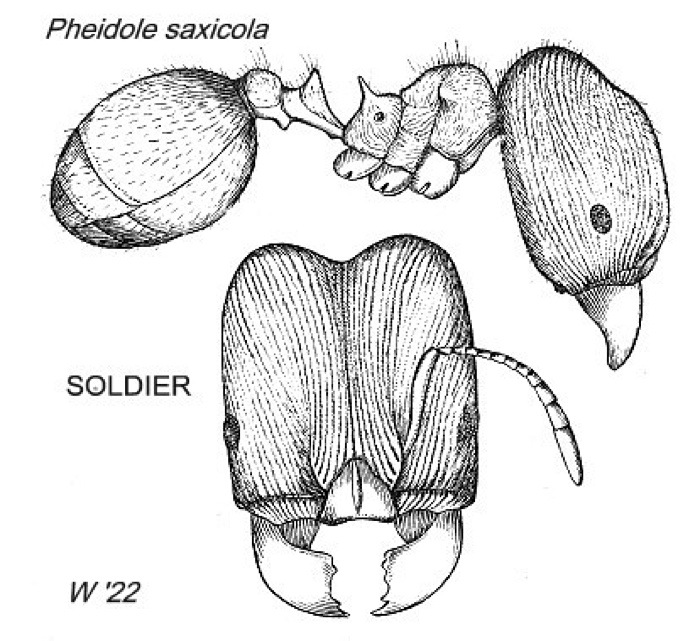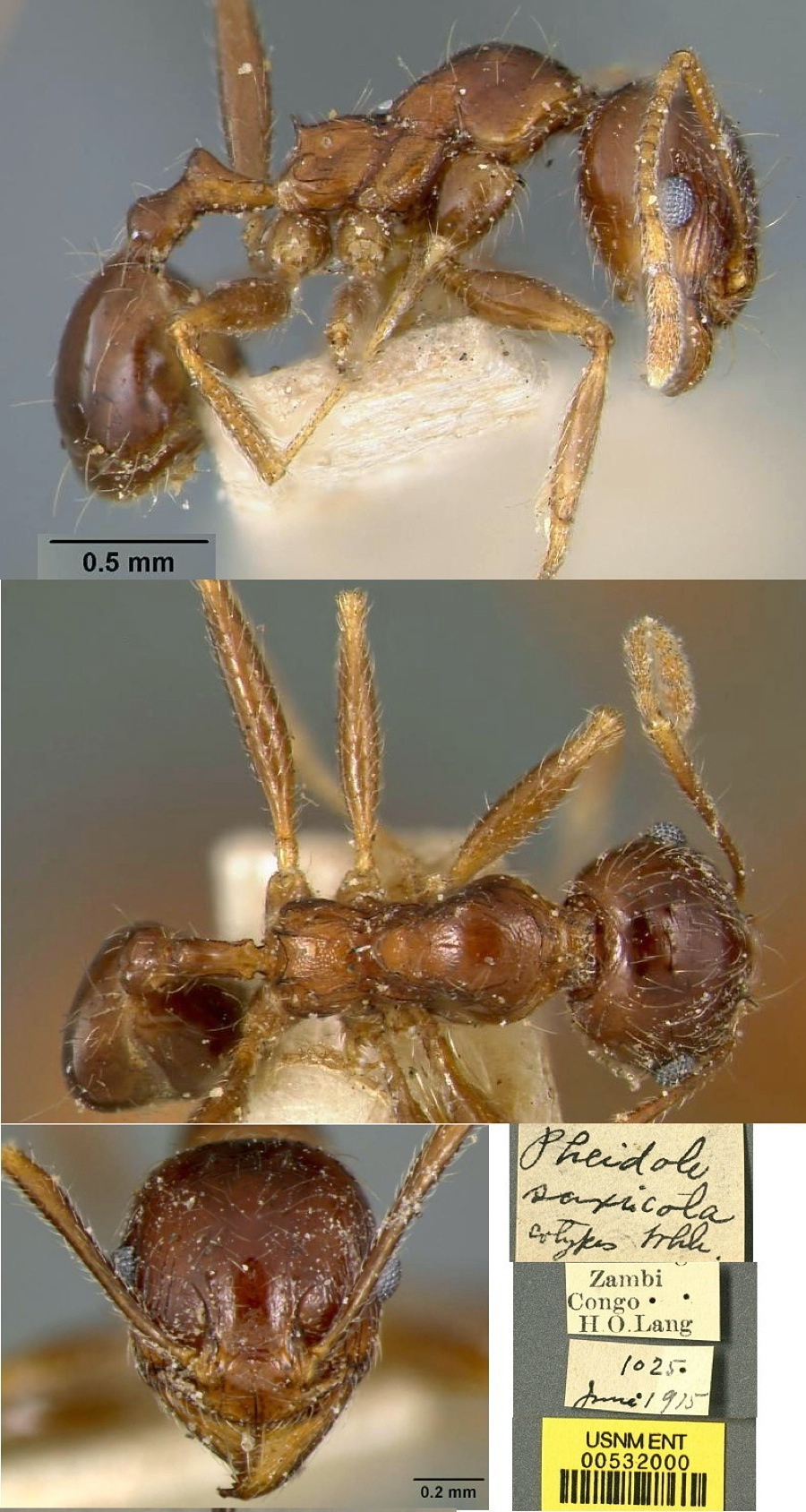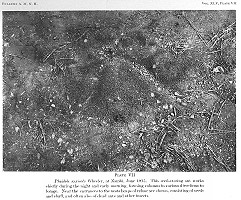Pheidole saxicola Wheeler
  Type location Zaïre
(Wheeler, 1922: 138, illustrated, major & minor) Type location Zaïre
(Wheeler, 1922: 138, illustrated, major & minor)  . .
Described from numerous specimens taken by Lang, Chapin,
and Bequaert, at Zambi, (type locality) and by the latter at Boma.
|
 MAJOR
- TL
ca 8.0 mm (from type images and Antweb scales, Wheeler had 5.5-6.0 mm
but other sizes match), HL ca 3.0, HW ca 2.8, SL ca 1.4, PW 1.33; CI
89, SI 50. Head subrectangular, nearly 3 mm. long and very
nearly as broad, scarcely broader behind than in front, with straight
subparallel sides, rectangular anterior corners, deeply and angularly
excised posterior border, and deep occipital and frontal groove. In
profile the occipital region is very feebly depressed and the eyes are
small, feebly convex, and at the anterior third of the sides. Gula
anteriorly with prominent, blunt teeth. Mandibles convex, with two
large apical and two basal teeth and a few denticles along the
intermediate border. Clypeus convex and carinate in the middle, its
anterior border broadly and feebly excised in the middle and sinuate on
each side. Frontal carinae very short, diverging; frontal area
distinct, with a median carinula. Antennae slender, scapes reaching the
middle of the head; funicular joints all longer than broad; club
shorter than the remainder of the funiculus. Thorax shorter than the
head, robust, through the pronotum nearly half as broad as the head,
with very blunt humeri, convex and rounded in profile. Mesonotum
sloping to the deep metanotal constriction with merely a trace of a
transverse convexity in the middle. Propodeum broader than long,
concave and sloping in the middle, in profile with the base distinctly
shorter than the declivity; spines short, suberect, acute, less than
half as long as the base and about half as long as their interval.
Petiole about one and one-half times as long as broad, broader behind
than in front, with concave sides; node transverse, its superior border
sharp, feebly excised in the middle. Postpetiole broader than long,
about two and one-half times as broad as the petiole, its sides
produced as short, acute, slightly backwardly directed spines, its
ventral surface with a small, acute tooth. Gaster smaller than the
head, subcircular or very broadly elliptical, somewhat flattened above.
Legs with moderately thickened femora. MAJOR
- TL
ca 8.0 mm (from type images and Antweb scales, Wheeler had 5.5-6.0 mm
but other sizes match), HL ca 3.0, HW ca 2.8, SL ca 1.4, PW 1.33; CI
89, SI 50. Head subrectangular, nearly 3 mm. long and very
nearly as broad, scarcely broader behind than in front, with straight
subparallel sides, rectangular anterior corners, deeply and angularly
excised posterior border, and deep occipital and frontal groove. In
profile the occipital region is very feebly depressed and the eyes are
small, feebly convex, and at the anterior third of the sides. Gula
anteriorly with prominent, blunt teeth. Mandibles convex, with two
large apical and two basal teeth and a few denticles along the
intermediate border. Clypeus convex and carinate in the middle, its
anterior border broadly and feebly excised in the middle and sinuate on
each side. Frontal carinae very short, diverging; frontal area
distinct, with a median carinula. Antennae slender, scapes reaching the
middle of the head; funicular joints all longer than broad; club
shorter than the remainder of the funiculus. Thorax shorter than the
head, robust, through the pronotum nearly half as broad as the head,
with very blunt humeri, convex and rounded in profile. Mesonotum
sloping to the deep metanotal constriction with merely a trace of a
transverse convexity in the middle. Propodeum broader than long,
concave and sloping in the middle, in profile with the base distinctly
shorter than the declivity; spines short, suberect, acute, less than
half as long as the base and about half as long as their interval.
Petiole about one and one-half times as long as broad, broader behind
than in front, with concave sides; node transverse, its superior border
sharp, feebly excised in the middle. Postpetiole broader than long,
about two and one-half times as broad as the petiole, its sides
produced as short, acute, slightly backwardly directed spines, its
ventral surface with a small, acute tooth. Gaster smaller than the
head, subcircular or very broadly elliptical, somewhat flattened above.
Legs with moderately thickened femora.
|
|
 Overall
shining throughout; mandibles coarsely striate, smooth and coarsely
punctate in the middle. Clypeus longitudinally rugulose, less
distinctly in the middle than on the sides. Head rather finely and
sharply longitudinally rugose, the rugae diverging on the front and
continued to the posterior corners, where they meet the also slightly
divergent rugae between the frontal carinae and the eyes. The
interrugal spaces are loosely reticulate. There are no transverse rugae
on the occiput but only a finer continuation of the more anterior
sculpture. Thorax, petiole, and postpetiole indistinctly and loosely
punctate rugulose, the prothorax transversely; propodeum with fine,
dense but shallow punctures, so that the surface is more opaque, Gaster
with fine, sparse, piligerous punctures. Hairs yellowish, partly
coarse, sparse, uneven and suberect and partly short, much more
abundant, softer and appressed or subappressed like long, coarse
pubescence. Legs with numerous short, oblique hairs; scapes with a few
longer spattered and coarser hairs. Overall
shining throughout; mandibles coarsely striate, smooth and coarsely
punctate in the middle. Clypeus longitudinally rugulose, less
distinctly in the middle than on the sides. Head rather finely and
sharply longitudinally rugose, the rugae diverging on the front and
continued to the posterior corners, where they meet the also slightly
divergent rugae between the frontal carinae and the eyes. The
interrugal spaces are loosely reticulate. There are no transverse rugae
on the occiput but only a finer continuation of the more anterior
sculpture. Thorax, petiole, and postpetiole indistinctly and loosely
punctate rugulose, the prothorax transversely; propodeum with fine,
dense but shallow punctures, so that the surface is more opaque, Gaster
with fine, sparse, piligerous punctures. Hairs yellowish, partly
coarse, sparse, uneven and suberect and partly short, much more
abundant, softer and appressed or subappressed like long, coarse
pubescence. Legs with numerous short, oblique hairs; scapes with a few
longer spattered and coarser hairs.
Colour dark ferruginous red; mandibles, sides and border of clypeus,
and frontal carinae, blackish; petiole, postpetiole, and gaster, except
more or less of the base of the first segment, dark brown or blackish.
Legs a little paler than the thorax.
|
 MINOR
- length 2.7 to 3 mm. Head subrectangular, as broad in front as behind,
with straight, subparallel sides, rounded posterior corners and nearly
straight posterior border. Eyes convex, at the middle of the sides.
Mandibles rather large, deflected at the tip, with denticulate apical
borders and two larger terminal teeth. Clypeus distinctly carinate,
with the anterior border very feebly sinuate in the middle. Antennal
scapes extending one-third their length beyond the posterior corners of
the head. Thorax similar to that of the soldier, but more slender,
especially through the pronotum. Propodeal dorsum a little longer than
the declivity; spines slender, acute, erect, about half as long as
their interval. Petiole slender, twice as long as broad, scarcely
broader behind than in front, with the sides only very faintly concave;
node transverse, its border distinctly notched in the middle.
Postpetiole twice as broad as the petiole, as long as broad,
subglobose, not toothed on the ventral side. Gaster about as large as
the head. MINOR
- length 2.7 to 3 mm. Head subrectangular, as broad in front as behind,
with straight, subparallel sides, rounded posterior corners and nearly
straight posterior border. Eyes convex, at the middle of the sides.
Mandibles rather large, deflected at the tip, with denticulate apical
borders and two larger terminal teeth. Clypeus distinctly carinate,
with the anterior border very feebly sinuate in the middle. Antennal
scapes extending one-third their length beyond the posterior corners of
the head. Thorax similar to that of the soldier, but more slender,
especially through the pronotum. Propodeal dorsum a little longer than
the declivity; spines slender, acute, erect, about half as long as
their interval. Petiole slender, twice as long as broad, scarcely
broader behind than in front, with the sides only very faintly concave;
node transverse, its border distinctly notched in the middle.
Postpetiole twice as broad as the petiole, as long as broad,
subglobose, not toothed on the ventral side. Gaster about as large as
the head.
Shining; mandibles subopaque, finely striatopunctate. Sides of head
delicately longitudinally rugulose and reticulate. Thorax, petiole, and
postpetiole finely and densely punctate, opaque; upper surface of
pronotum and postpetiole smooth and shining. Gaster and legs shining,
sparsely punctate. Pilosity like that of the soldier but less abundant.
Antennal scapes, like the legs, with numerous oblique hairs.
Colour brown; head darker above and behind; gaster, except the edges of
the segments, middle portions of legs, fore coxae, and usually also the
pronotum and upper surfaces of the petiolar nodes, darker than the
posterior portion of the thorax.
The photomontage of a cotype minor of the type form is
collated from The Smithsonian Institute images at http://ripley.si.edu/ent/nmnhtypedb/public/specimeninfopage.cfm?publicconsumption=1&typespecimenID=967.
|
 The
photomontage of a type collection major is collated from http://antweb.org/specimen.do?name=casent0913430. The
photomontage of a type collection major is collated from http://antweb.org/specimen.do?name=casent0913430.
See also the minor worker at http://www.antweb.org/specimenImages.do?code=rmcaent000017751
|
Oxford University Museum
specimens
Pheidole saxicola
B Taylor det.
|
Benin
J-F Vayssieres
RVA 2928.2
|
5.x.2012
Korobourou
09°22'13'' N
02°40'16'' E
|
Mangifera indica orchard
Quadrat 2, tube 1, variété: Kent
Ground nesting
Minor worker
|
1
|
 |
Pheidole saxicola
B Taylor det. |
Benin
J-F Vayssieres
RVA 3074.2
|
13.iii.2013
Koro
09°22'21'' N
02°40'13'' E
|
Mangifera indica orchard
prey of Oecophylla longinoda
1300-1400 h
minor
|
1
|
 |
Pheidole saxicola
B Taylor det.
Queen
|
Cameroun
A Fotso Kuate
Pheidole spC
|
17.vii.2007
Awae II
03°54'30" N
11°25'58" E
|
Quadrat in forest
queen undescribed
|
1
|
 |
Pheidole saxicola
B Taylor det. |
Congo
E Zassi
20-t-1 |
4-5.ii.2008
Lésio-Louna
03°20'12.0" S
015°28'43.6" E |
Village Mah; 24h
pitfall trap |
1
|
 |
|
 The
photomontage is of a worker from Benin, Korobouro; collector
J-F Vayssieres (RVA 2928.2). The
photomontage is of a worker from Benin, Korobouro; collector
J-F Vayssieres (RVA 2928.2).
|
 The
photomontage is of a second worker from Benin, Korobouro;
collector
J-F Vayssieres (RVA 3074.2). The
photomontage is of a second worker from Benin, Korobouro;
collector
J-F Vayssieres (RVA 3074.2).
|
 The
photomontage is of a damaged worker from Congo, Réserve de
Lésio-Louna, Village Mah; collector Eric Zassi (n sp 61; pitfall trap
20, t 1). The
photomontage is of a damaged worker from Congo, Réserve de
Lésio-Louna, Village Mah; collector Eric Zassi (n sp 61; pitfall trap
20, t 1).
|
 This ant is certainly very
closely related to P. sculpturata Mayr and might be regarded as
a subspecies, but it will fit neither Mayr's description of the typical
form from South Africa nor Santschi's and Forel's descriptions of the
various subspecies from East and West Africa. Mr. Lang's note shows
that it is a harvester. "The nests were found on a dry hill at the post
of Zambi in rocky soil". Mostly nocturnal, harvesting seeds about about
8 am, the majors carrying the seeds back to the nest (illustrated right
and "click"). This ant is certainly very
closely related to P. sculpturata Mayr and might be regarded as
a subspecies, but it will fit neither Mayr's description of the typical
form from South Africa nor Santschi's and Forel's descriptions of the
various subspecies from East and West Africa. Mr. Lang's note shows
that it is a harvester. "The nests were found on a dry hill at the post
of Zambi in rocky soil". Mostly nocturnal, harvesting seeds about about
8 am, the majors carrying the seeds back to the nest (illustrated right
and "click").
|
 The photomontage is
of a queen from Cameroun; Awae II; 03°54’30”N 11°25’58”E;
highland area elevation >500m; quadrat in forest; 17.vii.2007 (fk
pheidole spc); coll. A Fotso Kuate The photomontage is
of a queen from Cameroun; Awae II; 03°54’30”N 11°25’58”E;
highland area elevation >500m; quadrat in forest; 17.vii.2007 (fk
pheidole spc); coll. A Fotso Kuate
The overall morphology and colour strongly suggest this
is the undescribed queen of saxicola
|
|